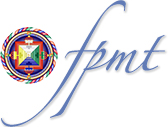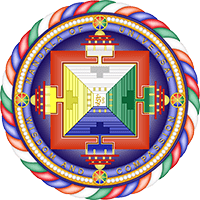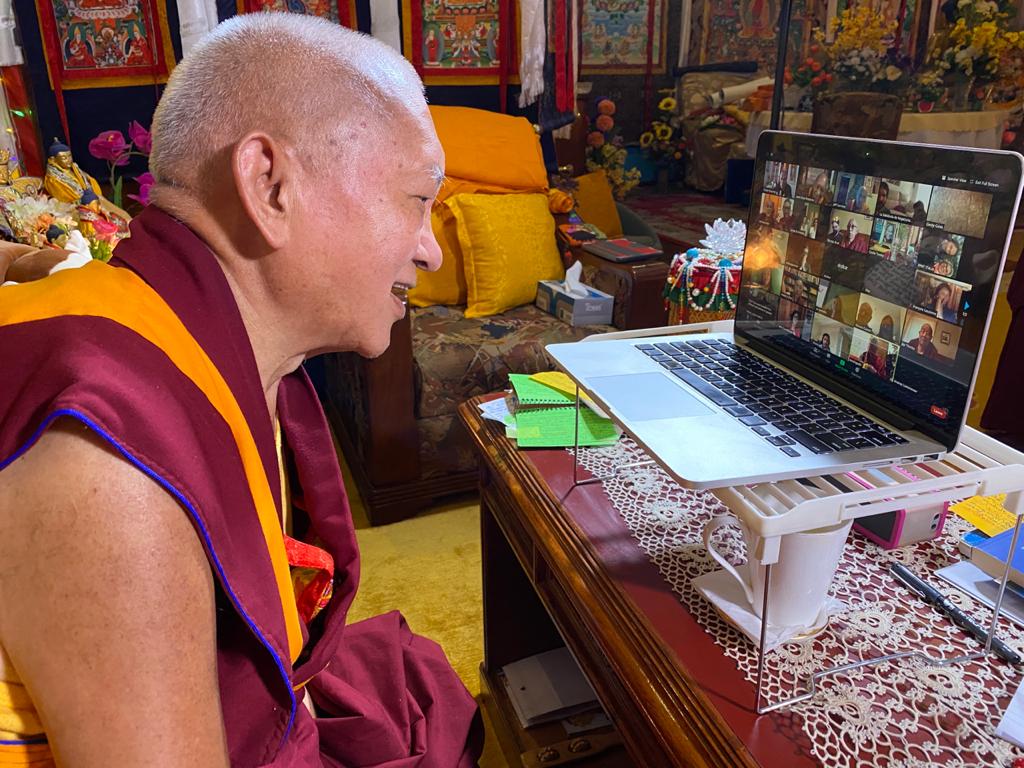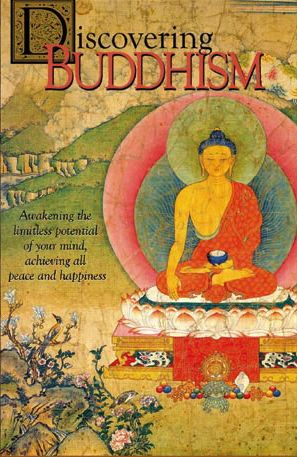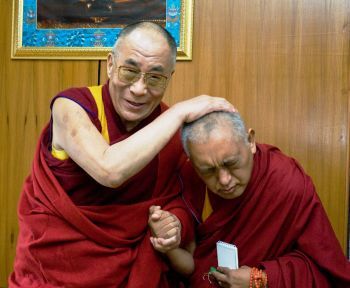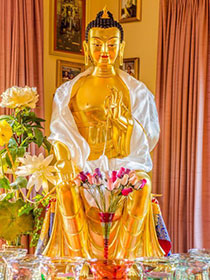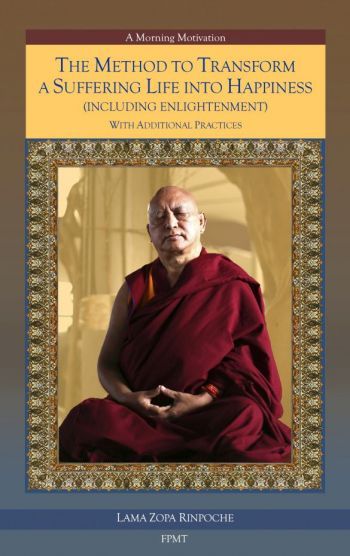- Home
- FPMT Homepage
Foundation for the Preservation of the Mahayana Tradition
The FPMT is an organization devoted to preserving and spreading Mahayana Buddhism worldwide by creating opportunities to listen, reflect, meditate, practice and actualize the unmistaken teachings of the Buddha and based on that experience spreading the Dharma to sentient beings. We provide integrated education through which people’s minds and hearts can be transformed into their highest potential for the benefit of others, inspired by an attitude of universal responsibility and service. We are committed to creating harmonious environments and helping all beings develop their full potential of infinite wisdom and compassion. Our organization is based on the Buddhist tradition of Lama Tsongkhapa of Tibet as taught to us by our founders Lama Thubten Yeshe and Lama Thubten Zopa Rinpoche.
- Willkommen
Die Stiftung zur Erhaltung der Mahayana Tradition (FPMT) ist eine Organisation, die sich weltweit für die Erhaltung und Verbreitung des Mahayana-Buddhismus einsetzt, indem sie Möglichkeiten schafft, den makellosen Lehren des Buddha zuzuhören, über sie zur reflektieren und zu meditieren und auf der Grundlage dieser Erfahrung das Dharma unter den Lebewesen zu verbreiten.
Wir bieten integrierte Schulungswege an, durch denen der Geist und das Herz der Menschen in ihr höchstes Potential verwandelt werden zum Wohl der anderen – inspiriert durch eine Haltung der universellen Verantwortung und dem Wunsch zu dienen. Wir haben uns verpflichtet, harmonische Umgebungen zu schaffen und allen Wesen zu helfen, ihr volles Potenzial unendlicher Weisheit und grenzenlosen Mitgefühls zu verwirklichen.
Unsere Organisation basiert auf der buddhistischen Tradition von Lama Tsongkhapa von Tibet, so wie sie uns von unseren Gründern Lama Thubten Yeshe und Lama Thubten Zopa Rinpoche gelehrt wird.
- Bienvenidos
La Fundación para la preservación de la tradición Mahayana (FPMT) es una organización que se dedica a preservar y difundir el budismo Mahayana en todo el mundo, creando oportunidades para escuchar, reflexionar, meditar, practicar y actualizar las enseñanzas inconfundibles de Buda y en base a esa experiencia difundir el Dharma a los seres.
Proporcionamos una educación integrada a través de la cual las mentes y los corazones de las personas se pueden transformar en su mayor potencial para el beneficio de los demás, inspirados por una actitud de responsabilidad y servicio universales. Estamos comprometidos a crear ambientes armoniosos y ayudar a todos los seres a desarrollar todo su potencial de infinita sabiduría y compasión.
Nuestra organización se basa en la tradición budista de Lama Tsongkhapa del Tíbet como nos lo enseñaron nuestros fundadores Lama Thubten Yeshe y Lama Zopa Rinpoche.
A continuación puede ver una lista de los centros y sus páginas web en su lengua preferida.
- Bienvenue
L’organisation de la FPMT a pour vocation la préservation et la diffusion du bouddhisme du mahayana dans le monde entier. Elle offre l’opportunité d’écouter, de réfléchir, de méditer, de pratiquer et de réaliser les enseignements excellents du Bouddha, pour ensuite transmettre le Dharma à tous les êtres. Nous proposons une formation intégrée grâce à laquelle le cœur et l’esprit de chacun peuvent accomplir leur potentiel le plus élevé pour le bien d’autrui, inspirés par le sens du service et une responsabilité universelle. Nous nous engageons à créer un environnement harmonieux et à aider tous les êtres à épanouir leur potentiel illimité de compassion et de sagesse. Notre organisation s’appuie sur la tradition guéloukpa de Lama Tsongkhapa du Tibet, telle qu’elle a été enseignée par nos fondateurs Lama Thoubtèn Yéshé et Lama Zopa Rinpoché.
Visitez le site de notre Editions Mahayana pour les traductions, conseils et nouvelles du Bureau international en français.
Voici une liste de centres et de leurs sites dans votre langue préférée
- Benvenuto
L’FPMT è un organizzazione il cui scopo è preservare e diffondere il Buddhismo Mahayana nel mondo, creando occasioni di ascolto, riflessione, meditazione e pratica dei perfetti insegnamenti del Buddha, al fine di attualizzare e diffondere il Dharma fra tutti gli esseri senzienti.
Offriamo un’educazione integrata, che può trasformare la mente e i cuori delle persone nel loro massimo potenziale, per il beneficio di tutti gli esseri, ispirati da un’attitudine di responsabilità universale e di servizio.
Il nostro obiettivo è quello di creare contesti armoniosi e aiutare tutti gli esseri a sviluppare in modo completo le proprie potenzialità di infinita saggezza e compassione.
La nostra organizzazione si basa sulla tradizione buddhista di Lama Tsongkhapa del Tibet, così come ci è stata insegnata dai nostri fondatori Lama Thubten Yeshe e Lama Zopa Rinpoche.
Di seguito potete trovare un elenco dei centri e dei loro siti nella lingua da voi prescelta.
- 欢迎 / 歡迎
简体中文
“护持大乘法脉基金会”( 英文简称:FPMT。全名:Foundation for the Preservation of the Mahayana Tradition) 是一个致力于护持和弘扬大乘佛法的国际佛教组织。我们提供听闻,思维,禅修,修行和实证佛陀无误教法的机会,以便让一切众生都能够享受佛法的指引和滋润。
我们全力创造和谐融洽的环境, 为人们提供解行并重的完整佛法教育,以便启发内在的环宇悲心及责任心,并开发内心所蕴藏的巨大潜能 — 无限的智慧与悲心 — 以便利益和服务一切有情。
FPMT的创办人是图腾耶喜喇嘛和喇嘛梭巴仁波切。我们所修习的是由两位上师所教导的,西藏喀巴大师的佛法传承。
繁體中文
護持大乘法脈基金會”( 英文簡稱:FPMT。全名:Found
ation for the Preservation of the Mahayana Tradition ) 是一個致力於護持和弘揚大乘佛法的國際佛教組織。我們提供聽聞, 思維,禪修,修行和實證佛陀無誤教法的機會,以便讓一切眾生都能 夠享受佛法的指引和滋潤。 我們全力創造和諧融洽的環境,
為人們提供解行並重的完整佛法教育,以便啟發內在的環宇悲心及責 任心,並開發內心所蘊藏的巨大潛能 — 無限的智慧與悲心 – – 以便利益和服務一切有情。 FPMT的創辦人是圖騰耶喜喇嘛和喇嘛梭巴仁波切。
我們所修習的是由兩位上師所教導的,西藏喀巴大師的佛法傳承。 察看道场信息:
- FPMT Homepage
- News/Media
-
- Study & Practice
-
-
- About FPMT Education Services
- Latest News
- Programs
- New to Buddhism?
- Buddhist Mind Science: Activating Your Potential
- Heart Advice for Death and Dying
- Discovering Buddhism
- Living in the Path
- Exploring Buddhism
- FPMT Basic Program
- FPMT Masters Program
- FPMT In-Depth Meditation Training
- Maitripa College
- Lotsawa Rinchen Zangpo Translator Program
- Universal Education for Compassion & Wisdom
- Online Learning Center
-
- Prayers & Practice Materials
- Overview of Prayers & Practices
- Full Catalogue of Prayers & Practice Materials
- Explore Popular Topics
- Benefiting Animals
- Chenrezig Resources
- Death & Dying Resources
- Lama Chopa (Guru Puja)
- Lama Zopa Rinpoche: Compendium of Precious Instructions
- Lama Zopa Rinpoche: Life Practice Advice
- Lama Zopa Rinpoche Practice Series
- Lamrim Resources
- Mantras
- Prayer Book Updates
- Purification Practices
- Sutras
- Thought Transformation (Lojong)
- Audio Materials
- Dharma Dates - Tibetan Calendar
- Translation Services
- Publishing Services
- Ways to Offer Support
- Prayers & Practice Materials
-
- Teachings and Advice
- Find Teachings and Advice
- Lama Zopa Rinpoche Advice Page
- Lama Zopa Rinpoche: Compendium of Precious Instructions
- Lama Zopa Rinpoche Video Teachings
- ༧སྐྱབས་རྗེ་བཟོད་པ་རིན་པོ་ཆེ་མཆོག་ནས་སྩལ་བའི་བཀའ་སློབ་བརྙན་འཕྲིན།
- Podcasts
- Lama Yeshe Wisdom Archive
- Buddhism FAQ
- Dharma for Young People
- Resources on Holy Objects
- Teachings and Advice
-
-
*If a menu item has a submenu clicking once will expand the menu clicking twice will open the page.
-
-
- Centers
-
- Teachers
-
- Projects
-
-
-
-
*If a menu item has a submenu clicking once will expand the menu clicking twice will open the page.
-
-
- FPMT
-
-
-
-
-
The office is a place for Dharma practice. When one goes to the office, dealing with people, one has to recognize it’s a place to practice lam-rim, the three principles of the path, tantra, and the six paramitas. The six paramitas fit very well for daily life. They offer protection for you. Everything is there.
Share
Lama Zopa Rinpoche
-
-
-
- Shop
-
-
-
The Foundation Store is FPMT’s online shop and features a vast selection of Buddhist study and practice materials written or recommended by our lineage gurus. These items include homestudy programs, prayers and practices in PDF or eBook format, materials for children, and other resources to support practitioners.
Items displayed in the shop are made available for Dharma practice and educational purposes, and never for the purpose of profiting from their sale. Please read FPMT Foundation Store Policy Regarding Dharma Items for more information.
-
-
10
Ask a Teacher: Addressing Doubt
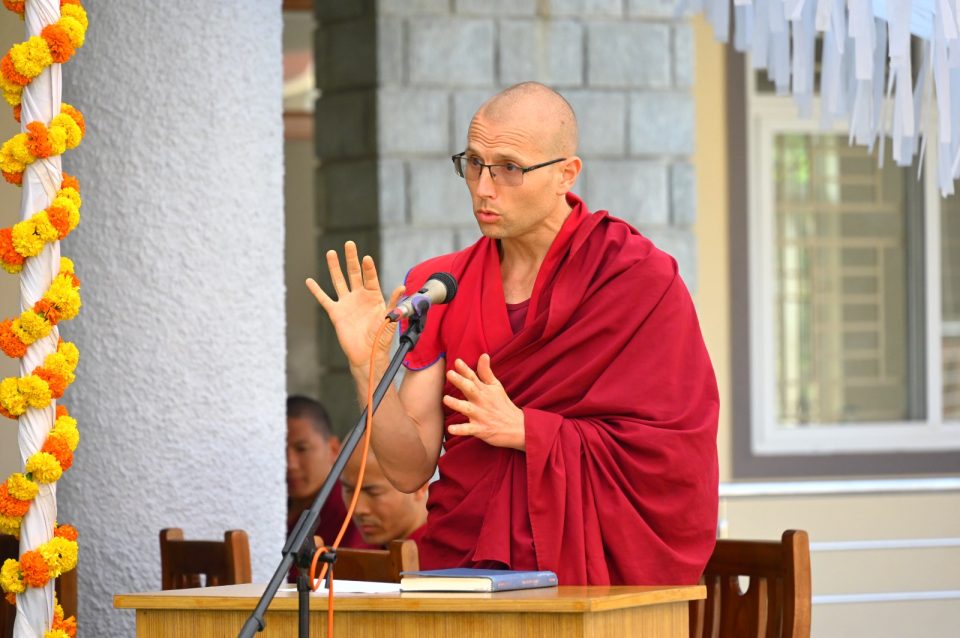
Ven. Gache explaining quantum physics to the senior monks at Sera Jey, January 2024/
Ven. Tenzin Gache, FPMT registered teacher and current director of Sera IMI House in South India, recently took the time to thoughtfully answer this question from a student: “How can we gain confidence in aspects of the Buddha’s teachings that are not accessible to our perception, for example, reincarnation?” As this question is familiar to all of us wishing to establish deep faith in Buddha’s teachings, we share his full answer below.
Addressing Doubt in the Buddha’s Teachings
By Ven. Tenzin Gache
Tibetan Buddhists in general, and especially followers of Je Tsongkhapa, consider themselves inheritors of the “Nalanda Tradition” that arose in ancient India. The trademark approach is critical investigation, rather than reliance on faith and adherence to established conventions. To question fundamental tenets of the Buddha’s teachings is not considered “bad karma” but is instead a dutiful display of respect for the lineage. This attitude is reflected in these passages, two attributed to the Buddha himself, and one from a contemporary master:
“It is fitting for you to be perplexed, Kalamas, fitting for you to be in doubt. Doubt has arisen in you about a perplexing matter. Come, Kalamas, do not go by oral tradition, by lineage of teaching, by hearsay, by a collection of scriptures, by logical reasoning, by inferential reasoning, by reasoned cogitation, by the acceptance of a view after pondering it, by the seeming competence [of a speaker], or because you think ‘the ascetic is our guru.’ But when you know for yourselves: ‘These things are wholesome; these things are blameless; these things are praised by the wise; these things, if accepted and undertaken, lead to welfare and happiness,’ then you should live in accordance with them.”[1] [“Logical reasoning” here is understood as reasoning divorced from empirical investigation, and does not imply that reasoning in general is not a necessary tool.]
Oh monks and scholars, as you would
test gold by burning, cutting, and
by rubbing it, just so accept
my words: not through respect for me.[2]
If scientific analysis were conclusively to demonstrate certain claims in Buddhism to be false, then we must accept the findings of science and abandon those claims.[3]
The Nalanda masters identified two possible approaches to the teachings: the “dull faculty” approach of faith or trust in a person, and the “sharp faculty” approach of critical analysis and trust in reasoning. Those who employ the first approach gain faith and enter the path more quickly, but those taking the second approach eventually gain an unshakable faith and, though slower to begin the path, will ultimately reach enlightenment far more quickly.
The second quotation above is seen as the source for the “sharp” approach, and later masters such as Aryadeva and Dharmakirti broke the advice into three parts, corresponding to three levels of analysis for three potential objects of knowledge:
- “Burning” symbolizes testing the manifestly obvious aspects of the teachings against our direct experience. If we can verify through sense consciousness (including with a microscope) that something the Buddha said does not accord with reality, we can and should discard it.
- “Cutting” symbolizes testing the slightly hidden aspects of the teachings against reason. The Buddha may have spoken of something we cannot directly experience, yet this teaching does not withstand reasoned analysis, we can discard it.
- “Rubbing” symbolizes checking the very hidden aspects of the teachings for internal contradiction. In some cases, the Buddha may have spoken of something that is only accessible to clairvoyance. We might not be able to test it against our experience or against reason, but if the teaching contradicts itself or another teaching the Buddha gave, we can put it aside.
A key point here is that it is considered inappropriate to employ a later stage of analysis at an earlier step. For example, if something is accessible to reasoning, we cannot appeal to textual authority to verify it. This is not simply a rule but reflects the stepwise approach. We always start with the earlier stages, so if something was accessible to reason, we would have already confirmed or rejected it before reaching the last stage. We only appeal to authority when something is beyond our ability to reason—and even then, we do so only with significant caution, as I will explain below.
The heart of the Buddha’s teachings is the four noble truths, and this teaching is the fulcrum upon which we weigh the other teachings. The four noble truths are a slightly hidden phenomenon, accessible to reason. If we have not used reason to establish these, then we have no basis for judging more esoteric claims. Critically, the teaching on karma and reincarnation forms an essential element of the four truths, as the interplay between the origin of suffering—karma and delusion—and the resultant suffering—aggregates arising under the power of karma and delusion. Reincarnation is something we must approach through critical analysis and not by appeal to the Buddha or someone else’s authority.
This point is sometimes misunderstood because certain teachings on karma are used as examples of very hidden phenomena. But the important distinction is between an understanding of karma in general rather than the result of a particular action. For example, in one sutra the Buddha claims that a particular lay supporter will be reborn as a monkey due to derogatorily calling an arhat a monkey. Although we can understand in a general sense that a concordant cause might lead to a particular concordant result, to know with certainty the result of any action we would need to know the details of all the myriad factors involved. What was the motivation behind the statement? Did the speaker regret it afterward? What other actions did he do in this or other lives that might be more powerful and override this action as the cause for the next birth? These are questions that can only be answered with profound clairvoyance. This distinction is analogous to predicting the weather—we can establish through reason and investigation the general patterns of meteorology, and make informed estimates about next week’s weather, but to know for sure that there will be a thunderstorm on Sunday would require knowing a nearly infinite interplay of causes.
If karma and reincarnation are accessible to reasoning, how can we approach them? The traditional teachings speak of employing either reason or scriptural quotation, but I think that today we can also talk about appeal to evidence. Ultimately our interpretation of evidence will depend on our use of reasoning, but gathering evidence in support of a hypothesis is in line with the dictum that we first appeal to direct perception. There is a wealth of high-quality evidence available, and a good introduction to the field can be found in Rebirth in Early Buddhism & Current Research by Bhikkhu Analayo.[4]
To use reasoning, we can first step back and ask, “What kind of world would have to be possible to allow for reincarnation?” A universe functioning solely according to the laws of classical physics would not allow for a nonmaterial mind to have any causal efficacy in the material world. Furthermore, a purely material mind—one that is either identical with, or a byproduct of, the brain—would not exist before birth and would cease at the time of death. These two notions—a classical universe and a material mind—are both ones that we can approach through reasoning and study of the available evidence. As serious practitioners of Buddhism, it is our responsibility to pursue such an approach, rather than appeal to either the authority of traditional Buddhist masters on the one side, or modern materialist scientists and philosophers on the other. This issue is too critical to the heart of Buddhism—to the truth or untruth of the four noble truths—for us to decide on hearsay. It is beyond the scope of this current essay to address the argument in detail, so I will do so in a subsequent one. The key point is that such investigation is not a diversion from serious practice but constitutes the practice of analytical meditation. The Buddha described practice as comprising study, contemplation, and meditation. What subject is more crucial to study and contemplate than the four noble truths? Liberation in Buddhism comes through wisdom seeing things as they are, not through reciting the right mantra formula or abiding in single-pointed concentration. These other practices can be utilized as powerful supplements for the development of wisdom but are not intended as replacements.
Finally, we come to the question of how to examine very hidden phenomena. Predicting specific details of karmic causation, like unfolding weather patterns, requires detailed knowledge of seemingly countless causes and conditions. Sense perception and even reasoned analysis alone cannot reveal these details. When the Buddha makes a claim about the karmic effect of a particular action, or the past cause leading to a present result, can we accept the statement as valid? The claim might not be “falsifiable” in the strict sense, but Nalanda masters developed tools that we can use to analyze the statement for potential flaws. Some traditional accounts speak of Mount Meru at the center of the universe. Mount Meru, if it exists, is not a very hidden phenomenon—it ought to be accessible to direct perception. If we use modern telescopes and other reliable devices and cannot perceive it, we can comfortably put such statements aside without controverting our adherence to Buddhist principles. We can also use modern methods of textual analysis to question the source of many statements, rather than assuming that any sutra attributed to the Buddha was indeed spoken by him. Tsongkhapa himself took such an approach in analyzing Indian texts, making maximum use of the tools available in fifteenth century Tibet.
In some sutras we see statements like “merely by reciting the name of Amitabha, you will be reborn in Sukhavati.” The Nalanda masters considered such a statement interpretable, meaning it cannot be taken literally because it contradicts teachings that can be verified by reasoning. If merely reciting the name of Amitabha led to birth in Sukhavati, there would be little need for cultivating ethical discipline, concentration, and insight. Karmic causation would essentially be nullified, because every other action a person did in their lifetime would have no bearing. The masters did not reject this statement but interpreted it in a nonliteral way. The teaching was meant for those who are easily discouraged, to uplift their spirits. The intention was not that simply reciting Amitabha’s name once would immediately lead to birth in Sukhavati after death, but that it would create a positive imprint that could lead to evolution over many, many lifetimes, eventually culminating in that result.
The Buddha’s claim that a particular lay adherent would be born as a monkey in the next life does not contradict his earlier teachings and is plausible within the framework of karmic causation. Does that mean that we can accept it? For one thing, to determine that it is plausible within that framework requires a deep understanding of the teachings on karma, and a conviction in their efficacy based on previous investigation. It also requires an understanding of what enlightenment is, and a conviction that the Buddha was an enlightened being. None of these points—the efficacy of karma, enlightenment in general, and even the Buddha’s enlightenment—is a very hidden phenomenon. Even if a practitioner has generated genuine valid cognition toward these points, it is questionable whether their conviction in the truth of the specific statement can ever reach the level of incontrovertibility that we can reach through reasoned analysis. The Geluk authors did indeed call such a conviction an “inference through belief,” but it is unclear whether Dharmakirti and his Indian contemporaries considered this sort of inference as on par with inference through the power of reason. In any case, we can be honest with ourselves about the limits of our knowledge. It is always possible that a statement attributed to the Buddha was not spoken by him. Even if it was, it is possible that he meant it in an allegorical way, as a skillful means to address the needs of disciples at the time. Even if it was meant literally, ascertaining its veracity hinges on conviction that the Buddha himself was infallible. This latter sort of conviction is not something that we can base on authority, but something that we must investigate with reasoning, taking us right back to the second stage of examining slightly hidden phenomena. Especially in the modern world, where there is a strong emphasis on questioning and reliable corroboration of unconventional claims, we as Buddhist practitioners cannot afford to lean on the authority of the past. We need courage and diligence to examine things for ourselves. We don’t pursue such examination just to convince others, but to confront our own doubt and work with our own minds. Doubt doesn’t leave us bewildered but clears a path that can lead to incontrovertible certainty when we are brave enough to follow that path as far as it will go.
Ven. Tenzin Gache is originally from Boston and graduated from Tufts University in 2005. During his college years he became a student of Lama Zopa Rinpoche and Choden Rinpoche. In 2006 he ordained with His Holiness the Dalai Lama, and has lived and studied at Sera Jey Monastery since that time. Currently he is in the final year of the standard geshe studies program, and next year will begin the intensive exams to qualify for the title of lharampa geshe.
[1] From the Kalama Sutta, found in Bhikkhu Bodhi, 2012. The Numerical Discourses of the Buddha. Boston: Wisdom Publications, p. 281.
[2] I have translated this verse from the Tibetan as it appears in Rje Tsong kha pa, 2002. Drang ba dang nges pa’i don rnam par ‘byed pa’i bstan bcos legs bshad snying po. Taiwan: The Corporate Body of the Buddha Educational Foundation, p. 3. Ironically, locating its original source within the Buddha’s teachings is a controversial matter, and most Tibetan scholars cited the quotation as it appears in an extant commentary by the Indian master Shantarakshita. Regardless of whether the Buddha made this exact statement, it certainly reflects themes he espoused in many other discourses.
[3] His Holiness the Dalai Lama, 2005. The Universe in a Single Atom. New York: Morgan Road Books, p. 3.
[4] Bhikkhu Analayo, 2018. Rebirth in Early Buddhism & Current Research. Boston: Wisdom Publications.
- Home
- News/Media
- Study & Practice
- About FPMT Education Services
- Latest News
- Programs
- New to Buddhism?
- Buddhist Mind Science: Activating Your Potential
- Heart Advice for Death and Dying
- Discovering Buddhism
- Living in the Path
- Exploring Buddhism
- FPMT Basic Program
- FPMT Masters Program
- FPMT In-Depth Meditation Training
- Maitripa College
- Lotsawa Rinchen Zangpo Translator Program
- Universal Education for Compassion & Wisdom
- Online Learning Center
- Prayers & Practice Materials
- Overview of Prayers & Practices
- Full Catalogue of Prayers & Practice Materials
- Explore Popular Topics
- Benefiting Animals
- Chenrezig Resources
- Death & Dying Resources
- Lama Chopa (Guru Puja)
- Lama Zopa Rinpoche: Compendium of Precious Instructions
- Lama Zopa Rinpoche: Life Practice Advice
- Lama Zopa Rinpoche Practice Series
- Lamrim Resources
- Mantras
- Prayer Book Updates
- Purification Practices
- Sutras
- Thought Transformation (Lojong)
- Audio Materials
- Dharma Dates – Tibetan Calendar
- Translation Services
- Publishing Services
- Teachings and Advice
- Find Teachings and Advice
- Lama Zopa Rinpoche Advice Page
- Lama Zopa Rinpoche: Compendium of Precious Instructions
- Lama Zopa Rinpoche Video Teachings
- ༧སྐྱབས་རྗེ་བཟོད་པ་རིན་པོ་ཆེ་མཆོག་ནས་སྩལ་བའི་བཀའ་སློབ་བརྙན་འཕྲིན།
- Podcasts
- Lama Yeshe Wisdom Archive
- Buddhism FAQ
- Dharma for Young People
- Resources on Holy Objects
- Ways to Offer Support
- Centers
- Affiliates Area
- Teachers
- Projects
- Charitable Projects
- Make a Donation
- Applying for Grants
- News about Projects
- Other Projects within FPMT
- Support International Office
- Projects Photo Galleries
- Give Where Most Needed
- FPMT
- Shop
Translate*
*powered by Google TranslateTranslation of pages on fpmt.org is performed by Google Translate, a third party service which FPMT has no control over. The service provides automated computer translations that are only an approximation of the websites' original content. The translations should not be considered exact and only used as a rough guide.Superficial observation of the sense world might lead you to believe that people’s problems are different, but if you check more deeply, you will see that fundamentally, they are the same. What makes people’s problems appear unique is their different interpretation of their experiences.
